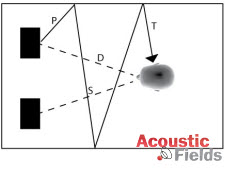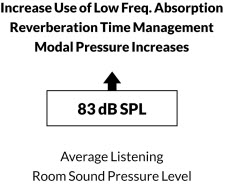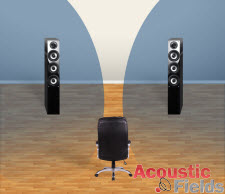It’s the time of year for saving money!
Every room has a limit on how much energy it can hold, especially in the low-frequency area, before it starts expressing its discontent through room modes. We just don’t want them. They actually prevent you from hearing some of your music and that’s just unacceptable. The speaker is producing the music the engineer and artist put in the recording, yet you can’t hear it. I find that completely unacceptable.
Gain Versus Emotion
Have you ever been in your room and listening to a passage of music and you’ve liked a particular guitar riff, drum solo or singer? What do you do? You grab the remote and you increase the gain (volume). What are you doing in that process? Do you want more music? I would argue that you want more emotional connection to the music but you’re going about it the wrong way. You’re reaching for a knob, you’re turning the knob to get more emotion. Now, that may work in that particular passage but it won’t work for the rest of the music in the room because it’s only that particular passage that you’re having an impact on.
Room Balance
What if you designed your room so that you didn’t have to turn it up all the time to get the emotional connection? What if the emotional connection was always there, every minute, and you never had to touch the remote? That’s the goal you should try to achieve in your listening room. You have to remember that a room is a box. It can only contain so much energy before it starts telling you enough is enough, and increasing the amount of energy you put into the room only makes all the associated acoustical issues worse.
Let’s say it’s going to start creating all this havoc at 60 Hz. You’re going to turn up the gain and maybe add 15 dB to the room response curve at 60 Hz and guess what you’re going to do at the listening position? You’re not going to hear anything at 60 Hz, or you’re going to hear too much depending if it’s a high- or low-pressure area at the listening position. There’s a balance between how much pressure the room can handle and what you can hear, and that needs to be taken into consideration. That’s the pressure side of it and this scenario can occur at frequencies below 200 Hz in today’s smaller rooms.
Room Reflections
 Now, let’s look at the reflection side of it. Reflections are room sound. When you turn up the gain, you increase the strength of reflections in the room — i.e., you increase their amplitude. It’s a delicate balancing act between the direct and reflected energy. The direct sound is travels in a straight line from your speakers to the listening position. All other energy is reflected energy from our room boundary surfaces. We don’t want too much direct and we don’t want too much reflected. We also want a balance between unwanted low-frequency pressure situations and reflections, and it’s a delicate balancing act. It’s not just, “Let’s put a system in a room, put two speakers where you think they look the best, and press the play button.” Nothing could be further from the truth, although I see it every day. We need to change that way we think.
Now, let’s look at the reflection side of it. Reflections are room sound. When you turn up the gain, you increase the strength of reflections in the room — i.e., you increase their amplitude. It’s a delicate balancing act between the direct and reflected energy. The direct sound is travels in a straight line from your speakers to the listening position. All other energy is reflected energy from our room boundary surfaces. We don’t want too much direct and we don’t want too much reflected. We also want a balance between unwanted low-frequency pressure situations and reflections, and it’s a delicate balancing act. It’s not just, “Let’s put a system in a room, put two speakers where you think they look the best, and press the play button.” Nothing could be further from the truth, although I see it every day. We need to change that way we think.
Two Systems: Electronic and Room
We need to look at everything as a system. You have a hi-fi system: speakers, amplifier, turntable, CD player, etc. Even cables are part of the system. Then you take that system and you put it in another system which is the room — the most important system of all. The room doesn’t care how much you spent for the amplifier. The room could care less about your speaker and, if you doubt that, come to my studio and I’ll give you an experience you’ve never had before with a $300 front end in a $100,000 room.
Cost No Object
It’s not about the quality and the price that you pay for the gear. It’s a system you’re placing inside of another system. And the system you’re putting it inside of — your room — has far more influence and impact than the speakers and amplifiers on your sound. This is what people don’t understand. They think that if you buy a new amplifier or a speaker, you’re going to get better sound. Now, if you put it in the same room, you’re going to get a different sound. The word here is different, not better. Do you really want to spend all that money for just different?
The room has all the control, so spend your money on fixing the room first. You don’t need to spend so much on electronics. Keep your speakers and gear and fix the room. Just spend 25% of the budget you spent on speakers and gear, you’ll get a 250% improvement on sound quality. That’s a great cost-benefit ratio. When you buy new speakers and a new amplifier without first addressing room acoustics, the room just laughs and says to itself, “Oh, another speaker and amplifier, let’s see what we can do to mess these up.”
The Schroeder Frequency
The room has a frequency that it “works” at. It’s called the Schroeder frequency. We won’t get into the technical side of it, but suffice it to say it’s the resonant frequency of the room. What is the resonant frequency of the room? Without getting too technical here, it’s the frequency at which the room talks to itself. Now this sounds really odd, but it’s the frequency based on the room size and volume at which certain energies are distributed throughout the room and how those energies above and below the Schroeder frequency contribute or detract from the overall sound quality of the room. It’s a break point number that tells us what our limits are.
Let’s put this another way. How much can a weightlifter handle at the gym? He knows he can bench press 150 pounds. He knows he can do that all day long but now his buddy says “let’s go to 175.” Well, his resonant frequency is 150, so he’s going to 175 and if he hasn’t properly trained and conditioned that body to lift the additional 25 pounds, he’s going to strain a muscle. Same thing in room acoustics. You have to match the usage to the room size and volume. You have to match the pressure that you’re going to be listening to music at for the room size and volume. All these are critical issues.
Balance All Inputs
You have to be very, very careful about what you’re doing. There’s nothing wrong with wanting more emotion from your music, but you won’t get that by increasing the gain. But all the time, I see people trying to do this. When I give demos in my studio, I don’t touch the gain control because I don’t want to influence the balancing act that we’ve achieved in the studio. Let everything come through on its own and natural volition, let all attack and decay rates move on their own. Let all energy live and die on its own by treating the room size correctly. Get the room out of the way as much as you can, so you can hear everything. That’s the goal and you should hear everything. If you hear everything, guess what? You naturally connect emotionally to the music. Hearing everything is hard because you’ve got to get the room out of the way.
]]>Pressure In Your Room?
It’s all about how much pressure can this box, your room, hold before it starts getting angry and expressing that discontent with room modes and unwanted resonances. Let me give you just some ideas here, so you get a handle on how powerful this marriage between electronic system, room size, and volume needs to be. Years ago, in Stereophile, the average listening level that listeners reported using was 83 dB SPL. In the testing we’ve done in our studio, this is about the level we listen at: 83, 84, 85 dB, somewhere in there. This is the level that I optimize the room for.
 Is that the level that the room likes? Is that level at which the room is not causing many issues? Yes, because I treated it to be that way. Now, when I increase the pressure level just to 84, 1 dB more, do I have issues in there that are unwanted? Not in my room because I have a range in my room that I work with. But in most rooms that don’t have the right amount of treatment, the difference between 83 and 84, just 1 dB, can excite the room modes that are untreated, can cause blurring and smearing and can produce unwanted delays in the reflections. So there’s an imbalance between direct and reflected energy. Just 1 dB can have this huge sonic impact on your room if it exceeds the treatment range of your room.
Is that the level that the room likes? Is that level at which the room is not causing many issues? Yes, because I treated it to be that way. Now, when I increase the pressure level just to 84, 1 dB more, do I have issues in there that are unwanted? Not in my room because I have a range in my room that I work with. But in most rooms that don’t have the right amount of treatment, the difference between 83 and 84, just 1 dB, can excite the room modes that are untreated, can cause blurring and smearing and can produce unwanted delays in the reflections. So there’s an imbalance between direct and reflected energy. Just 1 dB can have this huge sonic impact on your room if it exceeds the treatment range of your room.
Let’s go to 85. Now, we’re 2 dB over what’s normally used and considered standard. With more energy, we have more issues. If you have a non-treated, low-frequency room mode at the listening position, and it’s not excited at 83, maybe it is at 84, maybe it isn’t at 85, but will be again at 86. This goes back to our original discussion of matching the hi-fi system to the room system. There has to be a delicate balancing act between all of these variables. Too much energy from the wrong frequencies can upset the room sound balance.
 I see people all the time have 6- and 7-foot tall speakers in 8-foot-high rooms. Too much energy, too short of a distance between the floor and the ceiling, and you’re causing more problems than a room would normally exhibit on its own. Speaker size and room dimensions/volume must all be taken into consideration. People buy speakers because they think they look good. The room could care less what the speakers cost or look like. It’s all about balance: balancing the pressure, the balance of direct versus reflected energy, and matching the speaker size to the room size and volume.
I see people all the time have 6- and 7-foot tall speakers in 8-foot-high rooms. Too much energy, too short of a distance between the floor and the ceiling, and you’re causing more problems than a room would normally exhibit on its own. Speaker size and room dimensions/volume must all be taken into consideration. People buy speakers because they think they look good. The room could care less what the speakers cost or look like. It’s all about balance: balancing the pressure, the balance of direct versus reflected energy, and matching the speaker size to the room size and volume.
In Summary
There are two systems that need to marry together well. Your amplifier, CD player, speakers and cables are one system and the room is the other. I don’t care what anyone says, the room is the most important of those two systems. I don’t know why common thinking and perception has carried us to this point where amplifiers and speakers are elevated to god-like status. I just don’t get this and I surely don’t get it when I see the price of the some of this gear. Spending $500 per watt for an amplifier and putting that system in an untreated room is acoustic suicide.
The bottom line here is you’re working with systems, electronic systems which are both active and passive. All of these systems must be placed into a room. The room is now part of the system and it is the most important. It’s the president. Everything in that room works for the president, serves the president and if you keep that relationship in mind, you’ll have more emotional connectioni to the music then you know what to do with, and you won’t have to get a second mortgage to achieve it.





